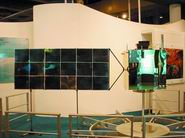 More than thirty application satellites are scheduled to be developed and launched in the next five years in China for economic development including those for live-broadcasts, telecommunications, meteorology, resources, navigation, marine services, and disaster-relief. For instance, the project for a direct-broadcast television satellite has already started and is to be launched in 2004. It can provide transmission service for high-quality TV programs, education and information. More than thirty application satellites are scheduled to be developed and launched in the next five years in China for economic development including those for live-broadcasts, telecommunications, meteorology, resources, navigation, marine services, and disaster-relief. For instance, the project for a direct-broadcast television satellite has already started and is to be launched in 2004. It can provide transmission service for high-quality TV programs, education and information.
Meanwhile, the launch of a seed breeding satellite in 2003 will cultivate suitable seeds for the western climate and help the agricultural advancement there.
China launched its first satellite known as Dongfanghong-1 to Earth orbit on its own "Long March" space rocket on April 24, 1970.
The launch made China the fifth nation with a space rocket.
China has made scores of successful satellite launches since 1970. By the end of 2001, China had launched about 50 satellites with a 90 percent success rate.
China has by now independently developed and launched about 50 satellites of various types with extensive applications in economic, scientific and technological and cultural fields, bringing about satisfactory social and economic benefits.
Altogether, five satellite series were developed in China:
FSW(Fanhui Shei Weixing, Recoverable Test Satellite)
 Recoverable satellites, used initially for military reconnaissance. In the late 1980s, the design was employed for earth resources photography and experiments in crystal and protein growth, cell cultivation and crop breeding. China was the third country in the world to master the technology of satellite recovery. Recoverable satellites, used initially for military reconnaissance. In the late 1980s, the design was employed for earth resources photography and experiments in crystal and protein growth, cell cultivation and crop breeding. China was the third country in the world to master the technology of satellite recovery.
DFH(Dongfanghong)telecommunications satellites.
China refers to its communications satellites as Dongfanghong(DFH). Dongfanghong means Fast Is Red.?
For fixed telecom service, China built scores of large and medium-sized satellite telecom earth stations, with more than 27,000 international satellite telephone channels. The establishment of the DFH-3 domestic satellite public communication network, with more than 70,000 satellite telephone channels, solved the problem of communication in remote areas. By 2000 the VSAT(Very Small Aperture Terminal)communication service had 30 domestic VSAT communication service providers and 15,000 small station users, including 6,300 two-way users(from areas such as finance, meteorology, transportation, oil, water resources, civil aviation, power, public health and media).
FY(Fengyun)meteorological satellites.
 Fengyun means Wind and Cloud.?The first of the six would be the polar-orbiting Sun-synchronous Fengyun-1D(FY-1D)was launched on May 15, 2002 on a Changzheng-4(Long March 4)rocket. Then, a geostationary weather satellite, FY-2C, would be launched in 2003. Fengyun means Wind and Cloud.?The first of the six would be the polar-orbiting Sun-synchronous Fengyun-1D(FY-1D)was launched on May 15, 2002 on a Changzheng-4(Long March 4)rocket. Then, a geostationary weather satellite, FY-2C, would be launched in 2003.
The FY-3 series would be the next generation of polar-orbiting Sun-synchronous weather satellites. FY-3A would be launched in 2004 with FY-3B and FY-2D in 2006, and FY-3C in 2008.
SJ(Shijian)
scientific research and technological experiment satellites.
China started to explore the upper atmosphere using rockets and balloons in the early 1960s. In the early 1970s, China began to utilise SJ satellites to obtain data on the space environment. The establishment of open state-level laboratories specialising in space physics, micro-gravity and space life science, and the founding of the Space Payload Application Centre provided the basis for public international collaboration on space science.
remote- sensing return satellites
When Ziyuan-2(ZY-2)was launched from the Taiyuan Satellite Launching Center in the northern Shanxi Province as a civilian Remote sensing?spacecraft. Ziyuan means Resource.?
The satellite would be employed mostly for territorial surveying, city planning, crop yield assessment, disaster monitoring and space science experimentation.
Satellite launch sites
The Jiuquan launch site
Located to the north of Jiuquan city in Gansu province. There were two launch pads at the Jiuquan launch site, complete with ground support facilities, from which 24 low earth orbit satellites were launched from 1970sintoshigher inclination orbits. In 1999 the facility was improved with a new Vertical Assembly Building and launch pad for heavy and manned launch vehicles.
The Taiyuan launch site
Located to the north of Taiyuan city in Shanxi province, the Taiyuan launch site was constructed for the launch of sun-synchronous and other polar orbit satellites.
The Xichang satellite launch center
Located near Xichang city in Sichuan province, the Xichang satellite launch centre was constructed for the purpose of launching geostationary satellitessintoslow inclination transfer orbits. Xichang has the geographical advantage of being at a relatively low latitude. All of China's geostationary satellites have been launched from Xichang, as well as foreign geostationary satellites launched by Chinese boosters.
| ![]() 本网站由北京信息港提供网络支持
本网站由北京信息港提供网络支持
![]() 本网站由北京信息港提供网络支持
本网站由北京信息港提供网络支持